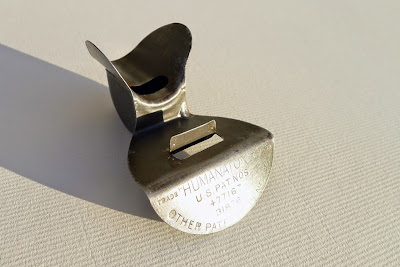
The box is printed on the four main sides, but nothing appears on the opening ones. It is printed in black on a natural (not colored) cardboard:

 |  |
The cardboard cutting is different (the small flaps are rounded on the beige one), and the glued flap was manually cut (irregular cut). Another difference is obviously the fact that the red box is negative-printed (it is the background which is inked, the scriptures being let unprinted).


All in all, simpler in the printings and in the text, the beige box is undoubtedly older than the red one.
The nose flute itself is very typical, in good condition, with visible solderings and clear but rather soft stampings.

 |  |

The lateral flaps are of the "bolster" type. And this causes me to revise the previous opinion I exposed there: the boldster type should be posterior to the "ice cream stick" type (but yet prior the "pear shape").

I am not able to date with precision this version of the Humanatone of the Stivers era, but I guess it should have been issued between the early 1910's and the early 1920's. A nice find, anyway!


Yes, a very nice find indeed! We wish noseflute.org a very nice sunday!
ReplyDeleteVielen Dank, miss Diva! Nice Sonntag to you to!
DeleteCongratuatulations on yet another wonderful find, with this awesome piece of history! I guess you could quite easily arrange a proper exhibition by now...:-)
ReplyDeleteHahaha! yes. I will soon make a picture of the Humanatone family!
Delete